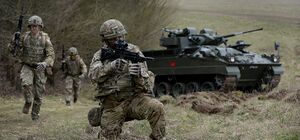Sentist War
This article is incomplete because it is pending further input from participants, or it is a work-in-progress by one author. Please comment on this article's talk page to share your input, comments and questions. Note: To contribute to this article, you may need to seek help from the author(s) of this page. |
| Sentist War | |||||||
|---|---|---|---|---|---|---|---|
 | |||||||
| |||||||
| Main Belligerents | |||||||
Supported by
|
Sentist Alliance
| ||||||
| Commanders and leaders | |||||||
|
| ||||||
The Sentist War, also known as the War in Ceris, was an armed conflict on the island of Ceris between a loose coalition of 7 states against the Sentists, a radical terror group. Beginning with the Sentist invasion of Hodrea in January 2020, the conflict raged throughout most of the island for over 16 months, coming to an end with the capture of High Priest Wetzel Carran and the subsequent collapse of the Sentist group. An estimated $$ million died in the conflict, most of which were civilians who lost their lives through the Sentist depopulation campaigns in northern Ceris. While some coalition forces have withdrawn, many remain in peacekeeping and humanitarian roles, with an estimated $$ soldiers and support personnel still deployed on the island.
Background
In 1944 the Seylosian Mandate commenced its war into Ceris. It quickly secured alliances with Eastern Ceris countries running into the Hodrean Kingdom, which controlled the rest of Ceris. Mandate tanks crossed the border in the early months of the year, quickly pushing back the Hodrean Kingdom. Though there were hard setbacks, eventually the Seylosian Mandate gained control of the entirety of Ceris, turning its eye away to the rest of the world. After the conclusion of the war, Seylos reverted back to its monarchy, releasing the whole of Ceris to the Hodrean Kingdom. What followed was a devastating series of independence wars which rocked the entire island.
Without the strong Seylosian occupation, the entirety of Ceris minus the east, fell into war. Splinter states appeared everywhere resulting in the many Ceriser countries that exist today. The most infamous of these wars occured between Hodrea and Rewhain, which resulted in the deaths of hundreds of thousands of Rewhainians but eventual independence for the country.
For some time after the wars for independence, peace was relatively prominent in Ceris. However the Ceriser population began to increase exponentially, far beyond its economic ability to sustain. With low economic opportunity, but access to more advanced Seylosian medical foriegn aid the population increased to the point where it was several times that the island of Seylos. In the early 2000s Seylos began a program to distribute aid across the island to combat the problem but it was only a bandage. Soon rival factions were at each others throats again vying for power. In 2004 the Hodrean control of Occlait collapsed leading to several warlords contesting for power over the vast area. The Dolch majority country of Rusheau began a campign of harrasment against its neighbors leading to several bloody border skirmishes.
Underneath it all a new religion had begun to form. One that had become obsessed with solving Ceris's problems of excess. Early on divisions had taken place in this new Sentist religion on dealing with the issue. In 2016, The Speaker began to rise in prominence amongst his people in the south, becoming a more moderate leader to the Sentist believers. In the north, a more radical leader began to emerge, The High Priest, devoting his preaching towards solving Ceris's real problem in his eyes. The population.
An alliance of convience occured and revolution spread throughout Ceris. Deep in the south the Speaker seized control of weak Ceriser governments establishing Sentist control and a government to rule it. In the north the High Priest had no such goals, sending forth his zealot armies to conquer as much as possible without the consideration of governance.